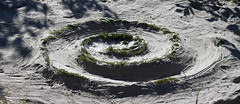When I discovered (several weeks after having constructed this mound of milkweed and earth at Wasaga Beach) that the milkweed plant springs forth from a rhizome…. well that changed everything.
The rhizome first intrigued me when Mark Cote assigned a few excerpts from A Thousand Plateaus (Gilles Deleuze and Félix Guattari, 1987) for reading in our "Philosophy of Computing" class at McMaster. Of course I’m not really a critical scholar, and I don’t really care to read all 800 pages (of which one reviewer remarked "There’s enough postmodern nonsense in this book to start a cult. Which, sadly, has happed").
Mostly, I just liked the idea that you could make a model of culture, especially of postmodern culture. Actually, the model doesn’t require any making – rhizomes have been around a lot longer than D&G’s collective intellect – but I give them a lot of credit for noticing these similarities in natural and cultural structure.
I too, enjoy discovering such models, and am in the middle of a process at he end of which I hope to have such a model for the theme of Creation, Fall, Redemption, Consummation. Those are pretty cosmic terms, and so they demand a lot of meshing of ideas; I think my current mode of meshing owes a great deal to D&G. Like me, they were also interested in trees, as a kind of counterpoint to the rhizome. (e.g. trees are hierarchical, and rhizomes are a distributed mesh). Since having apprehended the power of these images, I have assumed a kind of structural tension between the rhizomatic and the arborescent in almost all of my artworks.
And now I’m going to paraquote something heavy from Wiki:
"As a model for culture, the rhizome resists the organizational structure of the root-tree system which charts causality along chronological lines and looks for the originary source of "things" and looks towards the pinnacle or conclusion of those "things." "A rhizome, on the other hand, "ceaselessly establishes connections between semiotic chains, organizations of power, and circumstances relative to the arts, sciences, and social struggles." Rather than narrativize history and culture, the rhizome presents history and culture as a map or wide array of attractions and influences with no specific origin or genesis."
…so…
In this particular beach sculpture, there is an apparent (central) genesis, which implies that the spiral is only partial. But in principal, my sculpture does have (rhizomatic, free-flowing) spirality, as opposed to (arborescent, dualistic) linearity.
Suffice to say that milkweed and the spiral share some philosophical common ground.
—
At a later date, I’ll delve into the crazy beautiful paradoxes that this presents when meshed with my Christian faith. But for now this post has already sprouted enough branches.
